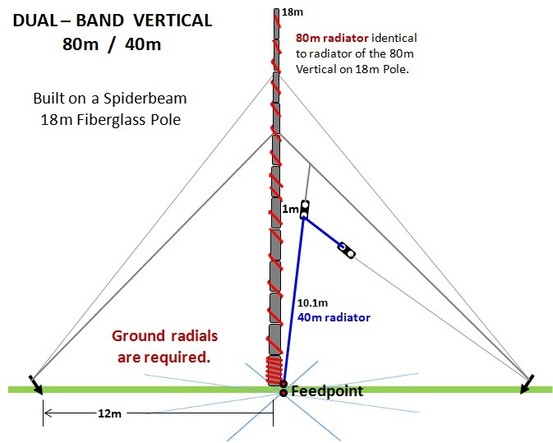80m/40m Dual-Band Vertical
On an 18m Spiderbeam Fiberglass Spiderpole
A DUAL-BAND (almost) FULL SIZE VERTICAL, WITH MONOBAND PERFORMANCE
Building Block Vertical
This dual-band vertical is the logical combination of our standard 80m vertical on an18m Spiderpole, with our 40m vertical on a 12m Spiderpole, except both wire verticals are supported by a single 18m Spiderpole. For more details, study the page on each of these monoband verticals. (simply clicks the Links in this paragraph)
The two wire radiators require a small amount of separation. 1m, as shown in the diagram above, is usually sufficient. The top on the 40m vertical wire will have to be folded back down along the guy rope because it is a little to long to terminate at the guy rope. This does not hurt performance.
As always, it is good to feed the vertical through a CMC Choke.
An RF-Choke at the feedpoint is recommended:
- 17 turns of RG-58 on an FT-240-43 (for a few hundred watts)
- For higher power, 17 turns of RG-142 or RG-303 on an FT-240-43 - use a stack of 2 cores for 1kw and 3 cores for 1.5kw.
Tuning:
Since the antenna is basically a full size vertical on both bands, tuning is simple and straight forward.
There are a couple of simple rules to follow:
- Cut wire lengths such that both bands will be resonant slightly too low.*
- TUNE 80m FIRST. THEN TUNE 40m.
- If you have problems tuning 40m, move the top insulator farther away from the pole; about 1.5m (5 ft.). Normally this is not necessary.
*Wires running along side a fiberglass pole incur a tiny change (reduction) in their velocity factor. If they run parallel to and against the pole, it is about 1%. If they spiral slowly down the pole, which is the best method to mount them, it is about 2%. This means if you cut the 80m radiator according to the formula, it will be 1 or 2% too long, which is what you should initially target anyway. Then you can shorten it as needed.
See the monoband 80m Vertical page for more details. The 40m radiator's velocity factor is not affected by this because it is far enough away from the pole.
CAUTION: Do NOT use Carbon-Fiber poles.
For vertical antennas, it is MUCH BETTER to use pure fiberglass poles. It is said that Carbon-Fiber poles absorb too much RF. Although I have not personally tried this, it has often been reported that a wire tightly mounted on a Carbon-Fiber pole has up to 2 S-Units of loss, compared to running that same wire a few inchs away from the pole.
Construction Tips:
As stated above, it is important to tune 80m BEFORE tuning 40m. Although it is easy to telescope a fiberglass pole up and down, once the 80m radiator has been tuned, you won't want to lower the pole to adjust the length of the 40m radiator.
Tip:
- Insert the 40m radiator wire through one end of a small LIGHTWEIGHT insulator before attaching its end insulator.
- Before raising the pole, tie the other end of this loose insulator to the guy rope that is to suport the 40m radiator, about 1m away from the pole, such that it hangs about 10cm (4 in.) below the guy rope.
- Use this insulator like a pully to raise and lower the 40m radiator with a "Pull-Rope". That way you can easily raise and lower it just enough for making adjustments.
- Tune the radiator by shortening it at the feedpoint. Be sure you have enough extra length in the support rope to allow for tuning.
- When finished, check that 80m is still in resonance where it should be. Normally it is not affected by the minor change in the length of the 40m radiator.
RADIALS:
Radials are VERY important for the efficiency
of this and every quarter-wavelength vertical.
A simple ground stake, or 1 or 2 radials per band is NOT ENOUGH.
If you want good results, you need at least 8 radials.
Sure you will read papers stating that you need 100 radials to get maximum efficiency from your vertical. No arguing that point, but what is misleading about that is, the return on investment after about 32 radials is very little. In fact 16 radials is already quite efficient and 8 radials is usually good enough for temporary portable operations. Of course more is better.
LENGTH OF RADIALS
Ground-mounted radials do not have to be resonant.
In fact it is better to have several short radial than a few long radials.
Radials should be anywhere between 1/8 and 1/4 wavelength long.
10m (33 ft.) is OK for this antenna. It works for both 40 and 80m.
The length is not critical, as long as it is at least 1/8 wavelength long on the lowest band.
If you put down 10 radials this length, you will have a good working vertical on both bands.
If time and circumstances permit, of course it is better to use a few more.
If possible, spread the radials symmetrically around the vertical.
If you are unable to do that in all directions, then just do the best you can.
Instructions
This document is not a step by step assembly manual, but it does show all of the necessary information to enable you to duplicate this antenna.
Dual Band Vertical 80-40.pdf
PDF-Dokument [292.6 KB]
Guying the 18m Pole.pdf
PDF-Dokument [94.7 KB]



























